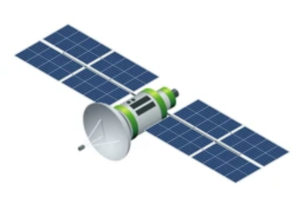VSAT (Very Small Aperture Terminal) Solutions refer to satellite-based communication systems that use small satellite dish antennas to establish high-speed data and voice connectivity in remote or rural areas where traditional terrestrial infrastructure is limited or unavailable. These solutions provide reliable and efficient communication services for various applications. Here’s an explanation of VSAT solutions:

- Satellite Communication: VSAT solutions rely on geostationary satellites positioned in orbit around the Earth. These satellites act as communication relays, receiving and transmitting data signals between the VSAT terminal and the central hub.
- VSAT Terminal: The VSAT terminal consists of a small dish antenna (usually 0.75 to 2.4 meters in diameter) installed at the customer’s location. It connects to the satellite, allowing two-way communication. The terminal also includes a transceiver to send and receive signals, a modem for data encoding and decoding, and other necessary hardware components.
- Central Hub: The central hub is a large earth station equipped with powerful antennas and network equipment. It serves as the main gateway for VSAT communications, managing the flow of data between the satellite and the wider network infrastructure.
- Data Transfer Process: When a user initiates a data transfer, the VSAT terminal sends the request to the satellite, which then relays the signal to the central hub. The hub processes the request and forwards the data to the appropriate destination, whether it’s another VSAT terminal, an internet service provider (ISP), or a specific network node. The response follows the same path in reverse.
Advantages of VSAT Solutions:
a. Broad Coverage: VSAT solutions can provide connectivity to remote and underserved areas where terrestrial infrastructure is limited or costly to deploy. They enable communication in locations without access to traditional wired or wireless networks.
b. Rapid Deployment: VSAT solutions offer quick deployment, allowing businesses or communities to establish communication networks in a relatively short period. This is especially crucial in emergency situations or temporary setups.
c. Scalability: VSAT networks can accommodate a wide range of users and can be easily scaled up or down as per the requirements. Additional VSAT terminals can be added to expand the network coverage and capacity.
d. Reliability: Satellite-based communication is resilient to physical infrastructure disruptions, such as natural disasters or infrastructure failures. VSAT solutions provide reliable connectivity even in challenging environments.
e. Wide Range of Applications: VSAT solutions are used for various applications, including internet access, voice and video communication, remote monitoring, disaster response, rural connectivity, and supporting critical operations in industries like maritime, oil and gas, and aviation.
In summary, VSAT solutions leverage satellite technology to provide reliable and efficient communication services in remote or underserved areas. They offer connectivity where traditional infrastructure is lacking, enabling businesses, communities, and organizations to stay connected and access essential services.